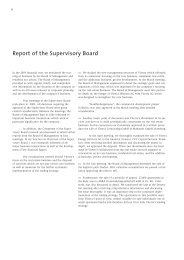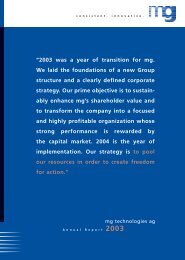Balfour Beatty - Corporate Responsibility Summary Report 2007
Balfour Beatty - Corporate Responsibility Summary Report 2007
Balfour Beatty - Corporate Responsibility Summary Report 2007
You also want an ePaper? Increase the reach of your titles
YUMPU automatically turns print PDFs into web optimized ePapers that Google loves.
In <strong>2007</strong>, operating companies continued to maintain the focus on improving<br />
the control measures of those activities that cause a potential risk to public<br />
safety.<br />
Safety by design<br />
Our aim is to design both permanent and temporary works so that health and<br />
safety risks are eliminated or reduced. For example, pre-fabrication off site in<br />
a factory environment can lead to better quality, faster construction, reduced<br />
costs and much safer work activity on site. Risks are designed out at source<br />
– for both workers and the public.<br />
This focus on design is reflected in our operating companies. Several hold inhouse<br />
forums to enable design teams to share best practice.<br />
The approach taken by <strong>Balfour</strong> <strong>Beatty</strong> Construction has already proved a<br />
success in <strong>2007</strong>. Along with Architects White Young Green and BDP a<br />
“Safety in Design Forum” has been established. The aim of the design forum<br />
is to develop a common hazard identification management and tracking<br />
system as a proactive alternative to the common approach to designer’s risk<br />
assessment.<br />
Haden Young and <strong>Balfour</strong> Kilpatrick are investing in pre-fabrication and<br />
modularisation. The reductions in build times, numbers of workers exposed to<br />
risks and elimination of common hazards are rewarding their commitments.<br />
Safety by design can be a simple affair. In Germany, <strong>Balfour</strong> <strong>Beatty</strong> Rail has<br />
replaced the need for mobile ladders on track by developing small flexible<br />
vehicles to access/egress the track. Additionally, to reduce work at height<br />
they have started to pre-assemble overhead catenary components on ground.<br />
To eliminate the traditional blind spots on site dumpers, <strong>Balfour</strong> <strong>Beatty</strong> Civil<br />
Engineering has developed a series of sensors that fit on the front of the<br />
dumpers.<br />
Work at height<br />
Following on from the success of our safety by design good practice DVD<br />
produced in 2006, a second volume was developed in <strong>2007</strong>. This focused on<br />
eliminating the requirement to work at height or reduce the risks associated<br />
with work at height through design and innovation. Innovations included<br />
vacuum lifting, modular cladding systems and vehicle edge protection<br />
systems.<br />
In <strong>2007</strong>, a continued effort was put into tackling the inherent risks from using<br />
Mobile Elevated Work Platforms (MEWP). To date 368 MEWP Coordinators<br />
have been trained in the International Powered Access Federation (IPAF)<br />
“MEWPs for Managers’ Course”. To support the training <strong>Balfour</strong> <strong>Beatty</strong><br />
MEWP coordinators’ guidance material has been developed. After sustained<br />
lobbying of the supply chain, one major UK supplier agreed to retrofit their<br />
existing supply of MEWPs to prevent accidents.<br />
Lifting operations<br />
The control of lifting operations remains a prime concern to some operating<br />
companies, and continues to account for the majority of notifiable dangerous<br />
occurrences. In <strong>2007</strong>, a total of 15 (15 in 2006) dangerous occurrences were<br />
were due to overturning or failure of lifting machinery/equipment.<br />
Lifting operations are supervised by trained and nominated crane coordinators,<br />
and each lift is controlled by an appointed person and certificated<br />
slingers. Further training was carried out for Crane Supervisors and Appointed<br />
Persons in safe lifting procedures in a number of operating companies.<br />
A cross operating company task group was appointed in <strong>2007</strong> to specifically<br />
look at the operation and procurement of tower cranes.<br />
Road safety<br />
Road safety remains a significant issue. We are concerned about both road<br />
traffic collisions and traffic management around our work sites, as these pose<br />
risks to both our employees and to third parties. In <strong>2007</strong>, road traffic collisions<br />
were the primary cause of <strong>Balfour</strong> <strong>Beatty</strong> worker fatalities.<br />
Additionally, in <strong>2007</strong>, 23 (18 in 2006) employees sustained injuries from road<br />
traffic collisions whilst on company business.<br />
We have several initiatives in place to address this risk. A cross operating<br />
company task group, formed in July 2006, developed and issued minimum<br />
standards for managing driving safety and a set of personal driving standards<br />
aimed at employees.<br />
Driver training, for the benefit of both car drivers and drivers of commercial<br />
vehicles, is conducted by operating companies in the UK, Hong Kong and<br />
Dubai.









